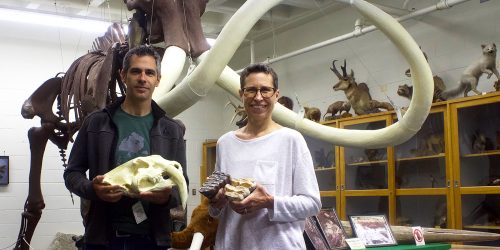
Daniel Gonzalez-Socoloske and Roshelle Hall hold specimens while standing in front of the “Prillwitz Mammoth,” the most complete Columbian Mammoth found in the state of Michigan. The mammoth’s remains were discovered in 1962 on the Wesley Prillwitz farm in Eau Claire, Michigan. [PC: Nicholas Gunn]
The Andrews University Museum of Nature & Science is developing new education programs to make the most of the specimens on hand. The museum has grown slowly but remained primarily unchanged since its inception in 1962, when it began as a collection of donated specimens used for teaching in the biology department.
The majority of the museum’s artifacts and collections have been donated over the years by alumni or members of the community, including the museum's most famous piece, the “Prillwitz Mammoth,” a Columbian Mammoth (Mammuthus columbi) discovered by a local farmer in Eau Claire, Michigan, in 1962.
One of the major recent changes in the museum was the addition of Roshelle Hall as adjunct assistant curator. Since taking the position in January 2022, Roshelle has been working alongside curator and professor of biology Daniel Gonzalez-Socoloske to improve various aspects of the museum and community engagement. The team is currently working on a three-pronged strategy for the Andrews University Museum of Nature & Science, including greater community participation and engagement, scientific collaboration and academic development.
Hall and Gonzalez-Socoloske agree that community engagement is a critical component of their museum development plan. “We're always thinking of new ways to connect with our community,” said Gonzalez-Socoloske. “To connect with our community on a deeper level, we will be revamping displays, putting a much more concerted effort into labeling specimens and setting up thematic displays. We also want to be much more intentional about our outreach programs that are anchored in the museum's mission, which is environmental education.”
The museum also intends to become a working museum that actively promotes scientific research. Hall emphasized the necessity of correctly categorizing specimens and making them accessible via internet databases, allowing scholars to obtain critical data without physically visiting the museum. This effort will improve collaboration among scientists around the world and help biodiversity research. “In discussions with other universities, they're excited to hear what we are planning to do with developing our online database of our unique specimens,” Hall explained.
The museum seeks to enrich Andrews University's curriculum by serving as a resource for various courses such as biology, art, design and education. Both Hall and Gonzalez-Socoloske believe that museum specimens and the new displays can provide hands-on learning opportunities that bridge theory with practical experiences. By engaging with a diverse range of disciplines, the museum can become a dynamic educational tool for students across the university, Southwest Michigan and even the world.
The museum is committed to being more accessible and relevant to a broader community. Plans include rebranding and revitalizing displays to focus on local ecosystems, global species and current pressing environmental issues. The museum looks to actively participate in groundbreaking work and events through outreach activities to educate and engage people of all backgrounds.
To learn more about visiting, volunteering, contributing to research or donating to the Andrews University Museum of Nature & Science, please contact assistant curator Roshelle Hall by email at hall@andrews.edu.
Nicholas Gunn, University Communication student writer